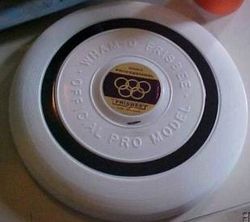Difference between revisions of "AY Honors/Ultimate Disc/Answer Key"
| Line 12: | Line 12: | ||
* [[Ultimate (sport)|Ultimate]] | * [[Ultimate (sport)|Ultimate]] | ||
| − | * [[Freestyle | + | * [[Freestyle]] |
* [[Guts]] | * [[Guts]] | ||
* [[Disc Golf]] | * [[Disc Golf]] | ||
Revision as of 17:55, 24 December 2005

While the word Frisbee is a registered trademark of the Wham-O toy company, the term is often used generically to describe flying discs similar to those made by the company. They are generally plastic, roughly 8 to 10 inches (20-25 cm) in diameter, with a lip. They are designed to fly aerodynamically when thrown with rotation and can be caught by hand.
A wide range of frisbee variants are available commercially. Disc golf discs are usually smaller but denser and are tailored for particular flight profiles such as stability or distance. When it was discovered that dogs enjoyed chasing and retrieving the slow-moving discs, special frisbees were designed with more pliable material that would better resist the dog bites. Disc dog competitions, in which dogs' frisbee-catching skills are judged, have become quite popular as well. Frisbee-like discs shaped like a Saturn's ring, known as aerobies, typically fly significantly farther than traditional frisbees.
History
The modern day frisbees are developed from the "Flying-Saucer", originally invented by Walter Frederick Morrison and codeveloped and financed by Warren Franscioni in 1948. However, the initial prototype was unsuccessful. A later model made by Morrison in 1955 and sold as the "Pluto Platter" was bought by Wham-O in 1957. The first flying discs rolled into production on January 13, 1957. In the next year, Wham-O renamed the toy "Frisbee", a (probably deliberate) misspelling of the name of the Frisbie Pie Company of Bridgeport, Connecticut, whose pie tins had been used by Yale University students in the campus for similar purposes.
Flying Disc Sports and Games
- Ultimate
- Freestyle
- Guts
- Disc Golf
- Durango Boot
- DDC Frisbee
- Flutterguts
- Friskee
- Frisbee dogs
- Dodge Frisbee
- Goaltimate
- Schtick
- Flutter Frisbee
Physics
The frisbee's rotation creates an angular momentum perpendicular to the horizontal plane, stabilizing the disc's attitude in high-speed flight. Small ridges near the leading edge act as turbulators, reducing flow separation by forcing the airflow to become turbulent after it passes over the ridges. Lift is generated in primarily the same way as a traditional asymmetric airfoil, that is, by accelerating upper airflow such that a pressure difference gives rise to a lifting force.
Richard Feynman in his book Surely You're Joking, Mr. Feynman! suggests that watching the wobble of a plate tossed in the MIT cafeteria stimulated him to develop mathematics that eventually led to his nobel prize winning work[1].
See also
- FRISBEE COLLECTIVE frisbeecollective.com This site celebrates the plastic disc, elevating it into an object of art that should be appreciated for its staying power and range of imagery... over 150 discs on display
- Descriptions of Frisbee throws
- Frisbeetarianism
- Giant Frisbee
Further reading
- Frisbee, A Practitioner's Manual and Definitive Treatise Stancil E.D. Johnson, M.D. Workman Publishing Company, New York (July, 1975) ISBN 0-911104-53-4
- The Official Frisbee Handbook Goldy Norton, Bantam Books, Toronto/New York/London (July, 1972) no ISBN number
- Frisbee Players' Handbook Mark Danna, Dan Poynter, Parachuting Publications, Santa Barbara, California (1978) ISBN 0-015516-19-5
- Frisbee Sports & Games Charles Tips, Dan Roddick, Celestial Arts, Millbrae, California (March 1979) ISBN 0-89087-233-3
- Frisbee by the Masters Charles Tips, Celestial Arts, Millbrae, California (March 1977) ISBN 0-89087-142-6
External links
- World Flying Disc Federation
- Frisbee, about.com
- Wham-O Frisbee disc website
- UK Ultimate Association
- Lookfly: for frisbee equipment
cs:Frisbee da:Frisbee de:Frisbee eo:Flugdisko fr:Frisbee it:Frisbee nl:Frisbee ja:フライングディスク no:Frisbee pl:Frisbee sk:Frisbee sv:Frisbee
